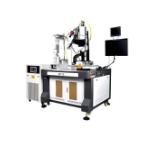The Advantages of Using an Automatic Laser Welder in Modern Man
-
In today's fast-paced manufacturing industry, precision, speed, and efficiency are critical. One technology that has revolutionized metal joining processes is the automatic laser welder. This advanced welding system offers unmatched accuracy, minimal heat distortion, and high repeatability, making it ideal for industries such as automotive, aerospace, electronics, and medical device manufacturing.
How an Automatic Laser Welder Works
An automatic laser welder uses a high-intensity laser beam to fuse materials together. The process is computer-controlled, ensuring consistent weld quality with minimal human intervention. The laser beam is precisely directed onto the workpiece, melting the material in a controlled manner to form a strong, clean weld.
Key components of an automatic laser welding system include:
Laser Source – Generates the laser beam (fiber, CO₂, or Nd:YAG).
CNC Controls – Ensures precise movement and positioning.
Automated Workpiece Handling – Robots or conveyors position parts for welding.
Vision Systems – Some models include cameras for real-time monitoring.
Benefits of Automatic Laser Welders
Superior Precision – Laser welding produces extremely fine welds, even on delicate or complex parts.
High Speed – Automated systems weld much faster than manual methods, increasing production rates.
Minimal Heat Affected Zone (HAZ) – Reduced thermal distortion preserves material integrity.
Versatility – Can weld various metals, including stainless steel, aluminum, titanium, and even dissimilar metals.
Consistency & Repeatability – Automation ensures every weld is identical, reducing defects.
Reduced Post-Processing – Clean welds often require little to no finishing work.
Applications of Automatic Laser Welders
Automotive Industry – Used for battery welding in electric vehicles (EVs), transmission components, and exhaust systems.
Medical Devices – Precision welding of surgical tools, implants, and sensors.
Electronics – Joining micro-components in circuit boards and semiconductor devices.
Aerospace – Critical for turbine blades, fuel systems, and structural components.
Conclusion
The automatic laser welder is a game-changer in modern manufacturing, offering unmatched precision, efficiency, and reliability. As industries demand higher quality and faster production, laser welding automation will continue to grow in importance. Investing in this technology can significantly enhance productivity while reducing costs in the long run.
